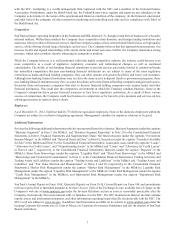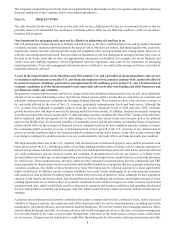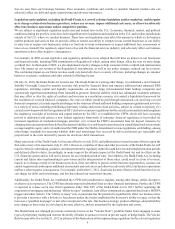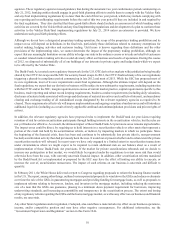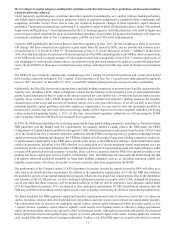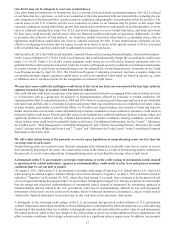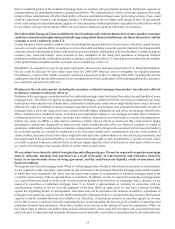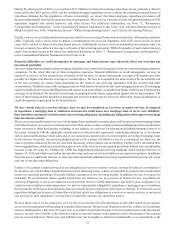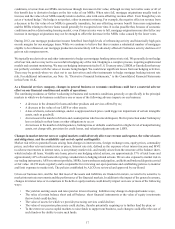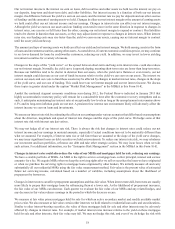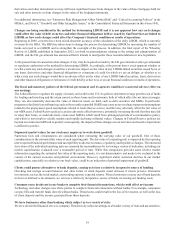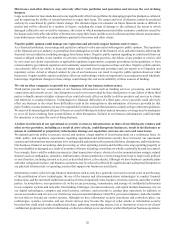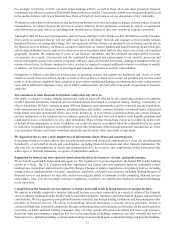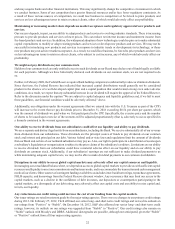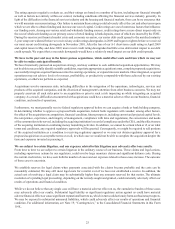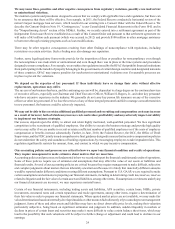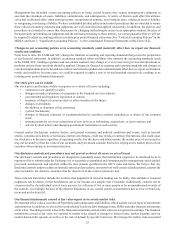SunTrust 2012 Annual Report Download - page 32
Download and view the complete annual report
Please find page 32 of the 2012 SunTrust annual report below. You can navigate through the pages in the report by either clicking on the pages listed below, or by using the keyword search tool below to find specific information within the annual report.16
extent they relate to securitized mortgage loans. In addition, if certain documents required for a foreclosure action are missing
or defective, we could be obligated to cure the defect or repurchase the loan. We may incur a liability to securitization investors
relating to delays or deficiencies in our processing of mortgage assignments or other documents necessary to comply with
state law governing foreclosures. The fair value of our MSRs may be adversely affected to the extent our servicing costs
increase because of higher foreclosure costs. Further, we may be subject to fines and other sanctions, including a foreclosure
moratorium or suspension or a requirement to forgive or modify the loan obligations of certain of our borrowers, imposed by
Federal or state regulators as a result of actual or perceived deficiencies in our foreclosure practices or in the foreclosure
practices of other mortgage loan servicers. Any of these actions may harm our reputation or adversely affect our residential
mortgage origination or servicing business.
In 2011, the Federal Reserve conducted a horizontal review of the nation's largest mortgage loan servicers, including us.
Following this review, we and other servicers entered into a Consent Order with the Federal Reserve. We describe the Consent
Order in Note 19, “Contingencies,” to the Consolidated Financial Statements in this Form 10-K and "Nonperforming Assets"
in this MD&A. The Consent Order required us to improve certain mortgage servicing and foreclosure processes and to retain
an independent foreclosure consultant to conduct a review of residential foreclosure actions pending during 2009 and 2010
to identify any errors, misrepresentations or deficiencies, determine whether any instances so identified resulted in financial
injury, and prepare a written report detailing the findings. On January 7, 2013, we, along with nine other mortgage servicers,
entered into an Acceleration and Remediation Agreement with the OCC and the Federal Reserve to amend the 2011 Consent
Order. This agreement ends the independent foreclosure review process created by the Consent Order, replacing it with an
accelerated remediation program. Pursuant to the agreement, we will make a cash payment of $63 million to fund lump-sum
payments to borrowers who faced a foreclosure action on their primary residence between January 1, 2009 and December 31,
2010, and will commit $100 million to affect loss mitigation or other foreclosure prevention actions. The impact of the cash
payment is included in our consolidated financial results at December 31, 2012, and we expect that our existing ALLL or
other activities will be sufficient to provide for the loss mitigation or other foreclosure prevention actions. We filed the Consent
Order as Exhibit 10.25 to our Annual Report on Form 10-K for the year ended December 31, 2011.
As a result of the Federal Reserve's review of the Company's residential mortgage loan servicing and foreclosure processing
practices that preceded the Consent Order, the Federal Reserve announced that it would impose a civil money penalty. At this
time, no such penalty has been imposed, and the amount and terms of such a potential penalty have not been finally determined.
We also continue with settlement discussions with the U.S. and States Attorneys General related to mortgage servicing claims
as discussed in Note 19, "Contingencies" to the Consolidated Financial Statements in this Form 10-K. We have accrued for
the anticipated cost of resolving these and other potential claims in our financial results.
We are subject to risks related to delays in the foreclosure process.
When we originate a mortgage loan, we do so with the expectation that if the borrower defaults then our ultimate loss is
mitigated by the value of the collateral which secures the mortgage loan. Our ability to mitigate our losses on such defaulted
loans depends upon our ability to promptly foreclose upon such collateral after an appropriate cure period. In some states, the
large number of foreclosures which have occurred has resulted in delays in foreclosing. In some instances, our practices or
failures to adhere to our policies has contributed to these delays (see “Management's Discussion and Analysis-Nonperforming
Assets” in this Form 10-K). Any delay in the foreclosure process will adversely affect us by increasing our expenses related
to carrying such assets, such as taxes, insurance, and other carrying costs, and exposes us to losses as a result of potential
additional declines in the value of such collateral.
We may continue to suffer increased losses in our loan portfolio despite enhancement of our underwriting policies and
practices.
We seek to mitigate risks inherent in our loan portfolio by adhering to specific underwriting policies and practices, which
often include analysis of a borrower's credit history, financial statements, tax returns and cash flow projections; valuation of
collateral based on reports of independent appraisers; and verification of liquid assets. Our underwriting policies, practices
and standards are periodically reviewed and, if appropriate, enhanced in response to changing market conditions and/or
corporate strategies. Examples include: client eligibility requirements, documentation requirements, loan types, collateral
types, LTV ratios, and minimum credit scores. Prior reviews have resulted in more stringent documentation standards, lower
maximum LTV ratios, and channel and client type restrictions. These actions have contributed to a reduction in exposure to
certain higher risk portfolio segments, such as higher risk mortgage, home equity, and commercial construction. These actions
have also contributed to declines in early stage delinquencies and nonperforming loans. While these changes have resulted in
improving asset quality metrics, elevated losses may continue to occur due to economic factors, changes in borrower behavior,
or other factors.
Our mortgage production and servicing revenue can be volatile.
We earn revenue from fees we receive for originating mortgage loans and for servicing mortgage loans. When rates rise, the
demand for mortgage loans usually tends to fall, reducing the revenue we receive from loan originations. Under the same



